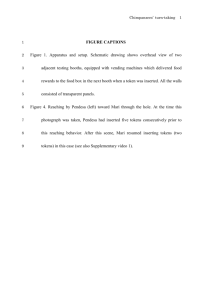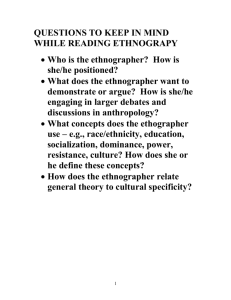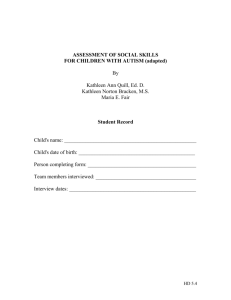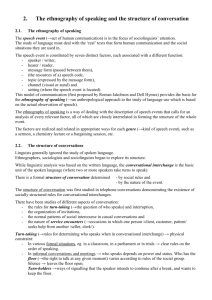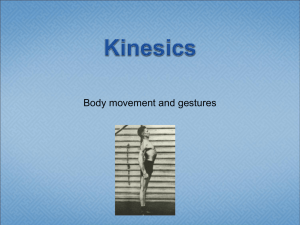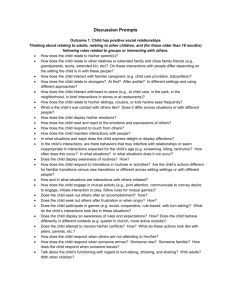conversation-analysis
advertisement
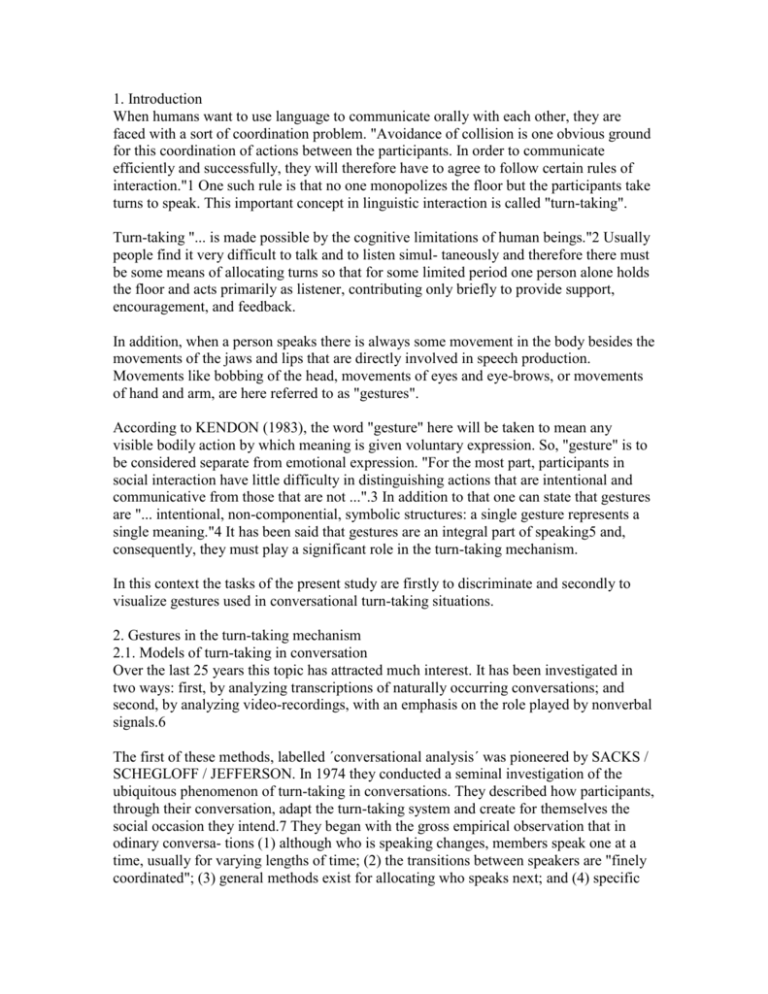
1. Introduction When humans want to use language to communicate orally with each other, they are faced with a sort of coordination problem. "Avoidance of collision is one obvious ground for this coordination of actions between the participants. In order to communicate efficiently and successfully, they will therefore have to agree to follow certain rules of interaction."1 One such rule is that no one monopolizes the floor but the participants take turns to speak. This important concept in linguistic interaction is called "turn-taking". Turn-taking "... is made possible by the cognitive limitations of human beings."2 Usually people find it very difficult to talk and to listen simul- taneously and therefore there must be some means of allocating turns so that for some limited period one person alone holds the floor and acts primarily as listener, contributing only briefly to provide support, encouragement, and feedback. In addition, when a person speaks there is always some movement in the body besides the movements of the jaws and lips that are directly involved in speech production. Movements like bobbing of the head, movements of eyes and eye-brows, or movements of hand and arm, are here referred to as "gestures". According to KENDON (1983), the word "gesture" here will be taken to mean any visible bodily action by which meaning is given voluntary expression. So, "gesture" is to be considered separate from emotional expression. "For the most part, participants in social interaction have little difficulty in distinguishing actions that are intentional and communicative from those that are not ...".3 In addition to that one can state that gestures are "... intentional, non-componential, symbolic structures: a single gesture represents a single meaning."4 It has been said that gestures are an integral part of speaking5 and, consequently, they must play a significant role in the turn-taking mechanism. In this context the tasks of the present study are firstly to discriminate and secondly to visualize gestures used in conversational turn-taking situations. 2. Gestures in the turn-taking mechanism 2.1. Models of turn-taking in conversation Over the last 25 years this topic has attracted much interest. It has been investigated in two ways: first, by analyzing transcriptions of naturally occurring conversations; and second, by analyzing video-recordings, with an emphasis on the role played by nonverbal signals.6 The first of these methods, labelled ´conversational analysis´ was pioneered by SACKS / SCHEGLOFF / JEFFERSON. In 1974 they conducted a seminal investigation of the ubiquitous phenomenon of turn-taking in conversations. They described how participants, through their conversation, adapt the turn-taking system and create for themselves the social occasion they intend.7 They began with the gross empirical observation that in odinary conversa- tions (1) although who is speaking changes, members speak one at a time, usually for varying lengths of time; (2) the transitions between speakers are "finely coordinated"; (3) general methods exist for allocating who speaks next; and (4) specific methods exist for constructing utterances so that the utterance displays ist status both as a following turn and as an utterance that allocates a next turn.8 The rules defined here function as an unnoticed resource that participants use for carrying on a conversation. On the other hand DUNCAN (1972), DUNCAN / FISKE (1977), or WIEMANN / KNAPP (1975) have carried out observational studies of conversational interaction which have suggested that gestural behaviour, in addition to speaker gaze, are of considerable importance in regulating the flow of social encounters. Today there is a large, valuable, and robust body of knowledge generated by many studies, which used a variety of analytical methods.9 The actual research often is concerned with the problems of turn-taking in discourse, especially as applied to intelligent interfaces, such as advice-giving systems or software help systems. A limitation of many discourse systems is their need for explicit turnending signals (e.g. pressing a return key).10 2.2. Development of turn-taking skills Turn-taking skills develop early. It has been found that the child begins to acquire knowledge about this organization of togetherness11 and its characteristic patterning which exists in and builds up the dialogue. It has been observed that communicative interaction, manifested in eye glances and taking place from the first week, gradually develops into an interaction with sounds where the adult talks and the child is cooing. So, at the early age of three or four months, the child has learnt the role play of conversation. As the child develops, his basic conversational skills develop with him. It may be suggested that nursery school children have already acquired certain aspects of those skills, including the gestural behaviour. 2. Gestures in the turn-taking mechanism 2.1. Models of turn-taking in conversation Over the last 25 years this topic has attracted much interest. It has been investigated in two ways: first, by analyzing transcriptions of naturally occurring conversations; and second, by analyzing video-recordings, with an emphasis on the role played by nonverbal signals.6 The first of these methods, labelled ´conversational analysis´ was pioneered by SACKS / SCHEGLOFF / JEFFERSON. In 1974 they conducted a seminal investigation of the ubiquitous phenomenon of turn-taking in conversations. They described how participants, through their conversation, adapt the turn-taking system and create for themselves the social occasion they intend.7 They began with the gross empirical observation that in odinary conversa- tions (1) although who is speaking changes, members speak one at a time, usually for varying lengths of time; (2) the transitions between speakers are "finely coordinated"; (3) general methods exist for allocating who speaks next; and (4) specific methods exist for constructing utterances so that the utterance displays ist status both as a following turn and as an utterance that allocates a next turn.8 The rules defined here function as an unnoticed resource that participants use for carrying on a conversation. On the other hand DUNCAN (1972), DUNCAN / FISKE (1977), or WIEMANN / KNAPP (1975) have carried out observational studies of conversational interaction which have suggested that gestural behaviour, in addition to speaker gaze, are of considerable importance in regulating the flow of social encounters. Today there is a large, valuable, and robust body of knowledge generated by many studies, which used a variety of analytical methods.9 The actual research often is concerned with the problems of turn-taking in discourse, especially as applied to intelligent interfaces, such as advice-giving systems or software help systems. A limitation of many discourse systems is their need for explicit turnending signals (e.g. pressing a return key).10 2.2. Development of turn-taking skills Turn-taking skills develop early. It has been found that the child begins to acquire knowledge about this organization of togetherness11 and its characteristic patterning which exists in and builds up the dialogue. It has been observed that communicative interaction, manifested in eye glances and taking place from the first week, gradually develops into an interaction with sounds where the adult talks and the child is cooing. So, at the early age of three or four months, the child has learnt the role play of conversation. As the child develops, his basic conversational skills develop with him. It may be suggested that nursery school children have already acquired certain aspects of those skills, including the gestural behaviour. 2.3. Turn taking cues While a number of studies have dealt with various behaviours which may be part of the turn-taking mechanism, only DUNCAN (1972) has dealt directly with it in its entirety. Taking an inductive approach, DUNCAN observed interactions, and then described the behaviour that accompanied speaking- role changes. According to DUNCAN, in conversation we use turn-yielding cues, back-channel cues, and turn-maintaining cues. WIEMANN / KNAPP (1975) also identified turn-requesting cues. 2.3.1. Turn-yielding cues Turn-yielding cues are used by speakers to let the listener know that they have finished what they want to say and that someone else may speak. The display of a turn-yielding cue does not require the auditor to take the floor; he may remain silent or reinforce the speaker with a back-channel cue. If the turn-taking mechanism is operating properly, the auditor will take his turn in response to a turn-yielding cue emitted by the speaker, and the speaker will immediately yield his turn.12 DUNCAN (1972) identified six turn-yielding cues in conversation.13 Five are verbal or paralinguistic and transmitted via the auditory channel. These include: A) intonation: the use of any pitch-level-terminal juncture combination other than at the end of a phonemic clause refers to a phonemic clause ending on a sustainded intermediate pitch level B) drawl on the final syllable, or on the stressed syllable, of a terminal clause C) sociocentric sequences: the appearance of one of several stereotyped expressions, typically following a substantive statement, e.g. "but ah", "you know", etc. D) pitch / loudness: a drop in paralinguistic pitch and / or loudness in con- junction with one of the sociocentric sequences. When used, these expres- sions typically followed a terminal clause, but did not often share the same paralanguage E) syntax: the completion of a grammatical clause involving a subject-predicate combination.14 The sixth turn-yielding cue involves gesticulation and is therefore transmitted via the visual channel. 2.3.2. Back-channel cues Back-channel cues are used by listeners to indicate that they do not wish to talk even though the speaker is displaying turn-yielding cues. So, the listener stays in his or her position when there is an opportunity to become the speaker. Vocal cues appropriate for this purpose include reinforcers (e.g., "Mm", "Oh"), completion of a sentence by the listener, or requests for clarification.15 There are also non-verbal cues to be found, for example, postural shifts, head nods or, hand gestures. 2.3.3. Turn-maintaining cues Turn-maintaining cues, in which speaking-turn claims are suppressed, are used by speakers to keep their speaking turn. Although hand gestures may constitute the most important nonverbal behaviour for this purpose, some vocal cues may be used alone or may accompany hand gestures. These vocal cues include increased changes in volume and rate of speech in response to turn-requesting cues from listeners. Using more filled pauses (with some form of vocalization, e.g., "Ah...") than silent or unfilled pauses is a useful method of turn-maintaining.16 2.3.4. Turn-requesting cues Turn-requesting consists of the display of one or more of a number of verbal or nonverbal cues by the listener. If the turn-taking mechanism is functioning correctly, the speaker should relinquish the speaking role upon completion of the thought unit he is communicating at the time the request is made.17 Turn-requesting is more frequently accomplished by simultaneous talking. Buffers and reinforcers are also used. Buffers are short words or phrases that are content-free and more or less stereotypical and that either precede or follow substantive statements (e.g., "but uh", "you know"). Buffers generally constitute a clear attempt by the auditor to get the floor. Occasionally, the buffers are uttered while the speaker is talking; but more often they are uttered while the speaker is silent, either during a pause or after the speaker has clearly ended his utterance. In the second case they seem to be a signal by the listener that he is ready to talk; the buffers allow the other participant time to attend to the new speaker before he begins his part. The use of buffers by the listener at this point may also constitute a signal to the speaker that he has accepted the speaker´s offer of the floor.18 Stutter starts are similar to buffers but may reveal a stronger demand to speak than buffers. Stutter starts are also likely to be used if the speaker has had the floor for fifteen to twenty seconds or if the speaker pauses longer than usual.19 © 1998, Ulrich Grün, Detmold 2.4. Varieties of gesticulation and body movements 2.4.1. Gazing behaviours Gazing here refers to looking toward the partner´s face. Auditor-directed gazes seem to be the most frequently occurring nonverbal yielding behaviour. WIEMANN / KNAPP (1975) found out that the percentage of time spent by the speaker looking at the face of the auditor increases steadily as the speaking turn approaches finality, while the percentage of time the auditor spends looking at the speaker increases from the first third to the second third of the interaction episode, and then drops off in the final third.20 As the speaker comes to the end of an utterance, he or she looks at the auditor in search of feedback. If this feedback is in the form of a verbal response, then the speaking role is likely to be exchanged. The looking away by the auditor seeems to be a response to the speaker - acknowledging the turn-yielding cue and the acceptance of the speaking turn. One can say that other-directed gazes function more as a turn-yielding device than as a turn-requesting device, but they can function as both. On occasion a person just stops speaking without looking directly at one of those being addressed or without indicating in some way who is to speak next. A period of silence may follow in the absence of a clear signal as to how the conversation is to continue.21 2.4.2. Head nodding Head nodding appears to play a major role in turn-requesting, while having lilttle or no significance in turn-yielding. Speakers do not systematically increase the amount of nodding as the episode progresses. On the other hand, there is a dramatic increase in nodding by the auditor. The rapidity of the head nods and whether or not they are accompanied by any verbal behaviour seems to determine how speakers interpret them. 2.4.3. Hand and arm gestures They are defined as hand and arm movements generally away from the body, which commonly accompany, and which appear to bear a direct relationship to, speech (e.g. an upraised and pointed index finger). Specifically excluded from the definition of hand and arm gestures are movements in which the hand comes in contact with one´s own body. Examples would be rubbing the chin, scratching the cheek, smoothing the hair, picking lint from the socks, etc. Such selfadaptors are very frequent for many individuals both while they are speakers and while they are auditors.22 2.4.4. Smiles and laughs Despite the large variety of aspects within the realm of communication, smile and laughter occur in the context of turn-taking. They appear to play a major role in backchannelling (e.g. a silent smile of feedback, perhaps coupled to direct eye contact). Nevertheless, a smile may stand at the end of a speaker´s turn as a request for taking over the turn. 2.4.5. Postural shifts During a conversation, a person may shift the position of his legs or may shift his seat in the chair. The role that shifts of posture play in the turn-taking mechanism is unclear. But one can assume that people do not really sit still in their seats for an appreciable length of time. Listeners may be reclining for a time and then, as they prepare to take the speaking role, move to an upright position or even to a forward-leaning position. On the other hand, speakers at times "punctuate" their yielding of the floor by leaning back in their chairs as they finish their utterances.23 © 1998, Ulrich Grün, Detmold 2.5. Differences in turn-taking In examining the functions and types of gesticulation and body movements in the turntaking mechanism, individual differences have not been mentioned. This section will attempt to give insight into the effects of sex, personality, and culture on the turn-taking mechanism. 2.5.1. Sex differences Though turn-taking cues are similar for males and females, one must consider sexual differences in the style of the operation of the turn-taking mechanism. Sex differences in human interaction are unapparent until about the fourth grade. At approximately this age, society´s influences begin to affect visual interaction. Environmental influences train women to be more aware of visual cues than men. Women are usually taught to give special attention to dress, colour, spatial arrangements, and so on. The eye contact of women becomes an emotional expression of striving to build social relationships. Women strive by looking more while speaking and being spoken to. It has also been observed that females look more at people they like but less when giving false impressions to the person in question. When males increase eye contact while talking they are seen to be more active than females with the same amount of eye contact. Apparently, both males and females look more at each other as the physical distance increases between them.24 DUNCAN / FISKE (1977) found out that the mean length of the males´ speaking turns was distinctly longer than the length of the females´ turns.25 The females smiled longer and more often than the males, engaging in smiling for a larger proportion of their nonspeaking time. The picture was similar for laughing: the females laughed more often, even if speaking or in the listening role. The females spent more time gazing at their partner than did the males. On the other hand the males shifted their seat position more than the females did. Concerning interruptions in conversation, representing a major violation of the turntaking rule, BEATTIE (1983) stated that in male-female conver- sation men interrupted much more frequently than women.26 In fact, nearely all of the analysed interruptions were initiated by men. 2.5.2. Personal differences Despite the apparently universal status of turn-taking, it may nevertheless appropriately be thought of as a highly skilled act. BEATTIE (1982) identified groups who are poor in executing turn-taking cues. For example, one of the major differences between shy people and others is the abilbty of the latter to initiate and structure conversations. The shy individuals have longer pauses between turns and speak less frequently and for a shorter percentage of the time.27 Clinical groups show even more marked effects. Conversations involving schizophrenics show marked disruption in turn-taking skills. The speech of neurotic patients often lacks continuity and is punctuated with too many silences; they fail to hand over or take up the conversation and generally, do little or nothing to control the interaction.28 Even turn-taking and interruption are effected by personality variables. It has been found that extroverts interupt, and speak simultaneously, more often than introverts. In threeperson discussion groups the less intelligent subjects interrupted more frequently than the more intelligent subjects.29 Individuals with greater eye contact are seen as attractive and described with favorable adjectives such as friendly, confident, sincere, and mature, while those subjects showing little eye contact are described as cold, pessimistic, defensive, and immature.30 According to BEATTIE one has to acknowledge the importance of differences in turntaking skills."Given the centrality of the turn-taking mechanism, individual differences in the style of its operation will undoubtedly influence interpersonal perception."31 2.5.3. Cultural differences Effective communication depends upon a shared understanding of behavioural cues. Moreover, the turn-taking rules are probably not generalizable to other cultures, even if they are for our own culture.32 It has been found that cross-cultural differences in patterns of turn-taking cues like eye behaviour are a potential problem in social interaction. Many visual turn-taking behaviours are different for blacks and whites. For example, there is a tendency for many blacks to avoid looking others directly in the eyes. Or, in one study, when the whites did speak they found themselves speaking while the blacks were speaking because of different interpretations of turn-taking cues.33 Another finding is that the British do not nod their heads to let you know they understand; rather, they will blink their eyes to let you know they have heard you. © 1998, Ulrich Grün, Detmold 3. Visualization 3.1. Method and procedure The central question of this study was how to visualize gestures in conversational turntaking situations. Firstly, a conversation had to be recorded. The results to be reported were based on transcriptions of speech and gestures during a 21 minutes long discussion of a couple. They were not exactly told about the purpose of the procedure. So, their interaction developed in a relatively natural way, apart from the fact that they were videotaped. Both teachers, the participants were told to discuss the topic of how to make best use of time. Their interaction was concentrated and getting more and more lively. Secondly, a decision had to be made in the question of visualization of the gestures included in the turn-taking mechanism. So, two video cameras were used to record the discussion. The cameras were set up in the back of each of the participants who were sitting face-to-face on two chairs. The cameras were at such distance from the participants that both of them were fully visible from head to foot on the tape at all times. As a consequence, more subtle details of facial expressions were not discriminable on the videotape. Less subtle expressions, such as broad smiles and grimaces, were discernable. In contrast, small movements of the hands and fingers, for example, were clearly evident on the tapes, so that fine discriminations of these movements could be made. No zoom techniques or other special focusing effects were used. Another decision had to be made in such an analysis is what constitutes a turn at talk. There has been widespread disagreement about this in the literature. According to BEATTIE (1982) in the present study only the vocal identifiers "mm-hmm", "ahh", and brief lexical terms such as "ja" and "okay" with attentional functions are excluded from the class of turns.34 So, there remains a large category of turns. At last, the videotapes were digitized and processed on a computer which made it possible to produce screenshots in order to discriminate the moments when gestures occured in the turn-taking mechanism. Those screenshots are presented in this paper and in the internet version. © 1998, Ulrich Grün, Detmold 3.2. Results In the present corpus, totalling 21 minutes, the female participant, here to be referred as participant 1 (p 1), held the floor 33 times and the male participant, participant 2 (p 2), held the floor 32 times. There were thus 64 exchanges of turn, including four simultaneous turns resulting from turn-taking attempts. The average time of one turn was about 19 seconds, but the enormous variability in length of a speaker turn has to be mentioned. Turns ranged from a couple of words to several thousands in length. One exceeded two minutes in duration. In the following there are 15 screenshots presented, some of them arranged as sequences taken from one turn-taking situation. The first sequence consists of pictures 1 - 5. The sequence was chosen as a typical example of gestural behaviour in the course of a change of turns. As picture 1 shows, p1 holds the floor. She gazes at p2, but doesn´t make use of any gestures. P2, on the other hand, is sitting still, holding eye contact to p1. Thus, picture 1 stands for a typical part of a smooth interaction. In picture 2 some things have changed. P1 still holds the floor with eye contact to p2. However, her posture has changed. Her body is a bit leaned back and her arms are crossed. This may be seen as her reaction to p2´s gestural behaviour who has set upright and started a self-adaptor (e.g. fumbling with a butto of his shirt) to indicate that he is willing to take the turn. Picture 3 shows the next step of the turn-taking process. While p2 continues to display his self-adaptor as a turn-requesting cue, p1 gives an open hand gesture to indicate that she is ready to leave the floor to p2. Eye contact is still lasting. Picture 4 exactly displays the moment of turn-taking. P1´s posture has nearely remained the same and she is gazing at p2 expecting his turn. P2 has turned away his head, concentrating on starting his turn. The start of his turn is accompanied by another selfadaptor reminding of rubbing one´s hands. Finally, p2 has taken the floor (picture 5). He typically uses a hand gesture to illustrate his thoughts. P1´s posture has remained the same. She is concentratedly listening to p2. Eye contact has been reestablished. Picture 6 shows a very strong gestural behaviour in the sense of turn- requesting. P2 holds the floor, using hand and arm gestures and is gazing at p1. P1 seems to be strongly affected by P2´s words, because she similarly produces a combination of gestures. Firstly, she shifts her posture by leaning forward her upper body and, seconcdly, she shows a broad smile. She has interrupted eye contact. P2 reacts and leaves the floor to p1. The next sequence includes pictures 7 - 9 and displays turn-requesting and turnmaintaining cues. P1 has held the floor for a longer time and p2 has shown some turn- requesting cues, for example some activities with his hands (picture 7). Obviously p1 is not willing to finish her turn, showing this by using an open hand gesture and maintaining eye contact. As p2 continues his turn-requesting activities, p1 passes over to another hand gesture (picture 8). She now uses her hands to enumerate important points of her thoughts, while having interrupted eye contact. So, her hand gesture, in combination with the interrupted eye contact, underlines that she is not willing to leave the floor to p2. As a result of that turn-maintaining behaviour p2 has stopped his gestural activities and is sitting still. P1 has re-established eye contact and continues her turn (picture 9). The next sequence (pictures 10 + 11) displays the situation of a successful interruption. As to be seen in picture 10, p2 holds the floor displaying a broad arm and hand gesture and is gazing at p1. P1 on the other hand has turned away her head and shows an angry face. Her left arm produces a very sharp gesture that really cuts off p2´s flow of speech. The result of that combined arm gesture and facial expression is that p2 has stopped his speech act and his gestures (picture 11). He is sitting still and gazing at p1 who has now taken the floor. She continues showing an angry face, but has reestablished eye contact. Pictures 12 and 13 give examples of back-channel cues. In picture 12 p2 is speaking. He displays no gestures and his gaze at p1 includes the question whether she is willing to take over the turn. However, p1 shows some backchannel cues, laying back her head and rubbing her chin. Moreover, she interrupts eye contact to p2. He reacts to these back-channel cues and continues speaking. Another back-channel situation can be observed in picture 13. This time p1 holds the floor, gazing at p2. As a back-channel cue he completely shifts his posture by turning away from p1 and looking down on the ground. In addition to that he nods and gives a verbal agreement to p1. As a reaction to these very strong back-channel cues p1 continues speaking. The last sequence (pictures 14 and 15) shows the situation of simultaneous speaking, a situation that should be prevented by a functioning turn-taking mechanism. As picture 14 reveals, both participants are speaking, both of them displaying hand gestures. P2´s hand gesture seems to be the more stressed one, because he is the one to keep the floor. His hand gesture is reinforced by a light shift of posture. P1 on the other hand, gives up the floor, demonstrating that by leaning back and shrugging her shoulders. So, she obviously shows that she gives up the floor. © 1998, Ulrich Grün, Detmold 4. Conclusions One thesis of this paper was that gestures are of considerable importance in regulating the turn-taking mechanism. Though the present study is based on one recorded discussion only, there are some conclusions concerning the role of speaker and listener gestures in conversational turn-taking situations to be made: There is evidence that the termination of a hand or arm gesture acts as turn- yielding cue. There is evidence that gestures act as an attempt-suppression signal. Interruption seems to be a situation which demands strong gestural behaviours or, the combination of different gestures. The fact, that there were only four interruptions in 64 exchanges of turn, indicates that the interaction analysed here was well organized and trained, as it was to be supposed for a couple. Generally, p2 made more use of gestures as p1. The appearance of multiple cues may also be related to the urgency of turn-yielding or turn-requesting. Auditors diplayed a wider variety of gestural behaviour and displayed those behaviours more frequently than did speakers. The line of thinking developed here suggests that a "grammar" of gestural interaction exists, the term "grammar" used as implication for the existence of a structure of interaction. There were parts of the interaction when no gestures could be observed, but in most parts of the conversation gestures were used even in turn-taking situations. Though the turntaking mechanism may not function without verbal cues, there was a large variety of gestures to be observed that accompanied and reinforced the turn-taking mechanism. © 1998, Ulrich Grün, Detmold References: Armstrong, David / Stokoe, William / Wilcox, Sherman (1995). Gesture and the Nature of Language. Cambridge University Press. Beattie, Geoffrey (1981). The Regulation of Speaker Turns in Face-to-Face Conversation: Some Implications for Conversation in Sound-Only Communication Channels, in: Semiotica 34/1-2 (1981),55-70. Beattie, Geoffrey (1982). Turn-Taking and Interruption in Political Interviews: Margaret Thatcher and Jim Callaghan Compared and Contrasted, in: Semiotica 39/1-2 (1982),93114. Beattie, Geoffrey (1983). Talk: An Analysis of Speech and Non-Verbal Behaviour in Conversation. Milton Keynes, Open University Press. Donaldson, Toby (1996). A Computational Theory of Turn-Taking, in: Proceedings of the Thirteenth National Conference on Artificial Intelligence and the Eighth Innovative Applications of Artificial Intelligence Conference,Vol.2. Duncan, Starkey Jr. (1972). Some Signals and Rules for Taking Speaking Turns in Conversations, in: Journal of Personality and Social Psychology 23/2 (1972),283-292. Duncan, Starkey Jr. / Fiske, Donald (1977). Face-to-Face Interaction: Research, Methods, and Theory. Hillsdale, Lawrence Erlbaum Associates. Harper, Robert / Wiens, Arthur / Matarazzo, Joseph (1978). Nonverbal Communication: The State of the Art. New York, John Wiley & Sons. Kendon, Adam (1983). Gesture and Speech: How They Interact, in: Wiemann,John M. / Harrison,Randall P. (1983). Nonverbal Interaction. Beverly Hills / London / New Delhi, Sage Publications, 13-46. Kendon, Adam (1975). Gesticulation and Speech: Two Aspects of the Process of Utterance, in: Key,M.R.: The Relationship of Verbal and Nonverbal Communication. The Hague / Paris / New York, Mouton Publishers,207-228. Larrue, Janine / Trognon, Alain (1993). Organization of Turn-Taking and Mechanisms for Turn-Taking Repairs in a Chaired Meeting, in: Journal of Pragmatics 19 (1993),177196. Malandro, Loretta A. / Barker, Larry L. / Barker, Deborah A. (1989). Nonverbal Communication. (2nd ed., 1st ed. 1983) Reading, MA: Addison-Wesley Pub. Co. Martin, Mary / Davis, Priscilla / Dancer, Jess (1996). Conversations Between Older Men and Women: Turn-Taking and Topics, in: Perceptual and Motor Skills 83 (1996),1330. Oreström, Bengt (1983). Turn-Taking in English Conversation. Malmö. Power, R.J.D. / Dal Martello, M.F. (1986). Some Criticisms of Sacks, Schegloff, and Jefferson on Turn Taking, in: Semiotica 58/1-2 (1986),29-40. Reed, James / Patton, Michael / Gold, Paul (1993). Effects of Turn-Taking Sequences in Vocational Test Interpretation Interviews, in: Journal of Counceling Psychology 40/2 (1993),144-155. Sacks, Harvey / Schegloff, Emanuel / Jefferson, Gail (1974). A Simplest Systematics for the Organization of Turn-Taking for Conversation, in: Language 50 (1974),696-735. Wardhaugh, Ronald (1985). How Conversation Works. Oxford / New York. Wiemann, John / Harrison, Randall (1983). The Nonverbal Domain: Implications for Theory, Research, and Practice, in: Wiemann,J. /Harrison,R. (ed.): Nonverbal Interaction. Beverly Hills / London / New Delhi, Sage Publications,271-286. Wiemann, John / Knapp, Mark (1975). Turn-Taking in Conversations, in: Journal of Communication 25 (1975),75-92. © 1998, Ulrich Grün, Detmold
